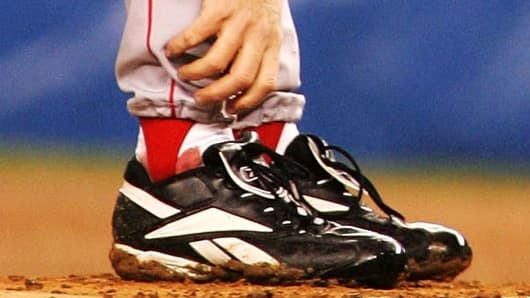The last time you bought socks, what did you pay? $10? $15?
How about $100,000?
That's the baseline expectation for the auction of Curt Schilling's "bloody sock" being auctioned off in New York (and online) by Heritage Auctions.
"This is obviously the first time we've ever offered a sock at auction," said Chris Ivy, Director of Sports Auctions for Heritage. "But it relates to a very significant moment in the World Series."
That moment was in Game 2 of the 2004 World Series when Schilling pitched on a bad ankle. The ankle had been sutured more than once during the playoffs, and the pressure of pitching with a damaged tendon led it to bleed through the sock.
Just hours after Schilling could hardly walk, he pitched six innings, only allowing a single run. The win helped the Red Sox win their first championship in 86 years, ending the infamous "Curse of the Bambino," which was in 1918 when the Red Sox sold Babe Ruth to the Yankees.
"As a one-of-a-kind piece, there's obviously a lot of interest in it," Ivy said. "Our estimate on this is $100,000 plus — as it was on the Buckner ball." The "Buckner ball" refers to the baseball that went through Bill Buckner's legs as the same Red Sox had an epic World Series collapse in 1986.
That infamous ball projected to sell for $100,000 when it sold last year, but it ended up fetching $418,000.
"We wouldn't be surprised to see this do something in that range," said Ivy, who said the high end would approach $600,000.
As of Thursday morning, bidding was up to just $60,000, but typically, bidding intensifies over the final 48 hours. According to Heritage, 90-percent of the bids come during that stretch, and the process culminates with a live auction Saturday night in New York City.
(Read More: Alternative Investing: Sports Memorabilia)
The backstory for the sale is not a good one. Upon retiring, Schilling invested heavily in his video game company. He even secured $75 million in loans from the state of Rhode Island. But last year, the company, "38 Studios," went bankrupt.
Schilling, who did not respond to requests to speak with CNBC, still works as an analyst at ESPN but needs the money to deal with his debt situation, despite making $114 million over an 18-year career.
It's an entirely different situation for the other marquee part of the auction: Mike Eruzione's 1980 Olympic items.
The hero from the "Miracle on Ice" — when Team USA stunned the Russians at the Lake Placid Olympics — is selling everything but his actual gold medal. The reason: It was just sitting in an attic, and he wants to take care of his children and their families financially.
For any American over the age of 40, especially, ahem, males who loved hockey and were born 10 miles from Eruzione's house, this game was the sporting experience of a lifetime.
Now, people can not only own the jersey Eruzione wore when he scored the game-winning goal, you can have his Olympic ID, t-shirt, hockey bag, shoulder pads, sweatsuit ... all but the gold medal.
(Read More: Cars That Just Sold for More Than $2 Million)
"We're expecting that it might be somewhere in the million and a half range, plus," Ivy said of the whole lot. "Obviously, a lot of that is going to depend on the miracle jersey."
The game jersey is currently at $375,000, and the expectation is that $1 million is the bottom of expectations. If a few wealthy bidders square off that number could double. Two-million dollars is quite a number for a hockey jersey, but that is what remains fascinating about this auction.
Right now, bidding for his knit hats from the Games? $140.
The accessible numbers for smaller items will actually drive up prices as the less wealthy fan considers making a commitment to any symbol from the iconic game.
(Read More: Art Not Only for '1 Percent', says Christie's Chief)
"It does run the gamet of values," Ivey said.
Or to some, there is only one value (priceless) and a gamut of values of bank accounts across the country.
By Sunday morning, we will know.
—By CNBC's Brian Shactman; Follow him on Twitter: @bshactman


